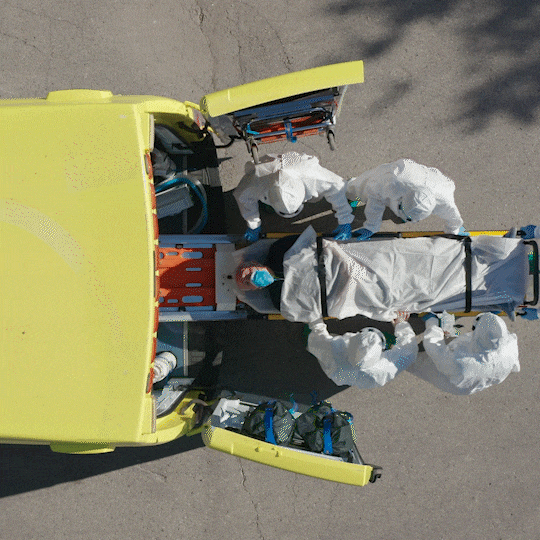WHAT IS A SUPERYACHT MEDICAL EVACUATION?
When we refer to a medical evacuation at MedAire Luxury Yachts, we are generally referring to the offboarding of a patient from a yacht to a medical facility, to improve their medical care. We may also arrange transfer to a higher level of medical facility, if required. Repatriation refers exclusively to the patient returning home for care.
When it comes to MedAire’s involvement in such a case, we are not to be confused with Emergency Medical Services (EMS) like Search and Rescue (SAR) who are generally the first to provide on-the-scene treatment to those in need of urgent medical care.
Evacuations can be stressful and scary for everyone involved, not to mention expensive and whilst most of the cases we assist with don’t require an evacuation, we are well prepared should one be necessary.
MedAire clients are secure in knowing the decisions being made are with the patient’s best interest in mind and the best resources available. Our standards ensure: medical and logistic due diligence, overall cost effectiveness, as well as client-specific requirements, we are there to facilitate a smooth evacuation.
Here’s how the process works:
A MEDICAL EMERGENCY OCCURS
Step 1. Moving the patient off the boat

When the very first call comes in to MedAire following a medical emergency, we remotely assess the patient, swiftly directing you to equipment and specific pouches for medicines, to enable you to improve the patient’s outcome.
Having decided that the patient requires urgent attention on shore, we may help by sourcing relevant emergency service numbers, corresponding with the hospital to make arrangements for the incoming patient and anything that assists in enabling you within the evacuation process.
In general, MedAire don’t arrange the local paramedic, heli-evac or other emergency services to attend your vessel, as these types of services need to be in direct communication with the vessel.
As our reach is global, we may also have the ability to leverage local International SOS/MedAire Assistance Centres, to help the case run more smoothly, for example sending a nurse to liaise with staff and ensure that appropriate care is being given within the facility.
Step 2. Establishing the need for a medical evacuation

Once the patient has arrived at that particular facility and is stabilised, our goal is to establish whether the risk of moving them is ultimately better than leaving the patient in the existing facility.
MedAire doctors assess the following key criteria to help make that decision:
- The nature of the symptoms and medical condition, based on validated information from various sources
- The natural progression of illness or trauma
- The complication rate (i.e. worst case scenario
Based on the above, the MedAire doctor must determine whether the local medical facilities are adequate to manage the medical condition in question – both for the time being and if/when a serious complication occurs.
To decide this, a thorough understanding of the current medical capabilities and their quality is necessary.
Step 3. Understanding the medical facilities and standard of care.
MedAire and our parent company, International SOS, have developed a network of medical providers and local health care systems, which are approved and verified by our internal team for their high standards of care.
The team look at a variety of criteria such as:
- The training levels of doctors, nurses and staff
- Specialties. What is available at the facility, and are they functional (i.e. a CT Scanner is available, but there are no trained staff to run it)
- Feedback received about the facility and what to expect when coordinating or during treatment.
- In addition, we also consider local medical conditions. For example, the quality of their blood products (how are they tested, how are they stored), and the prevalence of counterfeit medications in the region.
Step 4. Identifying appropriate receiving care and how to transport the patient
If the need to move the patient is established, the next step is sourcing the nearest suitable medical facility or specialist, this might be: a paediatric intensive care unit, a specialist burn unit, a general medical ward, or a coronary care unit for example.
As with the previous steps, MedAire consider a huge range of factors when moving a patient to a different location, the most important of course being the patient’s current condition but also taking into consideration: accessibility of the facilities, surgical capabilities, medical resources available for diagnostics and treatment, the ability for the facility to provide ongoing care, potential security concerns as an Ultra High Net Worth individual, as well as financial considerations, to name a few.
.jpg?width=596&height=397&name=Paris%20assistance%20centre%20employee%20on%20the%20phone%20with%20map%20window%20background%20(3).jpg)
Step 5. Determining method of medical evacuation
Once the need for an evacuation is confirmed and the facility identified, our team consider the options which might include: ground ambulance, commercial carrier, air ambulance or a combination.
Some clients/patients have access to a personal or corporate aircraft, however most MedAire patient transportations are undertaken on scheduled commercial airlines.
A key consideration that will inform the patient’s ability to travel on a commercial flight is whether they can fly as a seated passenger or if they require a stretcher, given that most commercial flights can’t accommodate stretcher.
We also look at:
- Whether a medical escort or non-medical companion needs to accompany the patient
- If special attention or specific equipment is needed for the patient I.e. oxygen requirements, medical equipment required with type of battery, disposal of bio-hazard materials, etc.
- Logistical issues
- Toileting
- Seat availability on the commercial flight
- Plan B considerations in case of delays or cancellations
- Medical status of patient
- Are they contagious?
- Could their condition disturb other passengers?
- Could their condition deteriorate at altitude?
- Will they pass medical clearance?
Step 6. When air ambulance is the best option

If any of the above considerations (specialist equipment, urgency of patient’s condition, airlines not accepting the patient’s medical clearance etc) raise cause for concern, an air ambulance is required.
In this scenario, MedAire can source an appropriate aircraft from our approved, credentialed list of providers. Air ambulances are not all the same, so as with all the previous stages we need to consider a number of variables like: range and speed of the aircraft, medical configuration, seating onboard for the medical team and travel companion, medical staffing etc.
In parallel to this, we’re weighing up a huge number of other variables including weather conditions, the potential for security incidents that could affect air travel and the ability for social uprisings as well as strikes to influence the flight.
EXPERT CARE, EVERWHERE
As we’ve shown medical evacuation require a huge amount of work, knowledge and expertise, so in the unlikely event of an evacuation, it’s imperative that MedAire are at your side.
As a MedAire client our evacuation support is included within your membership. We also work closely with insurers, through Direct Billing Agreements (DBA). When we have a DBA in place, we can invoice the insurer directly for any covered expenses, making the process even more streamlined.
Find out more about the MedAire comprehensive membership here.

